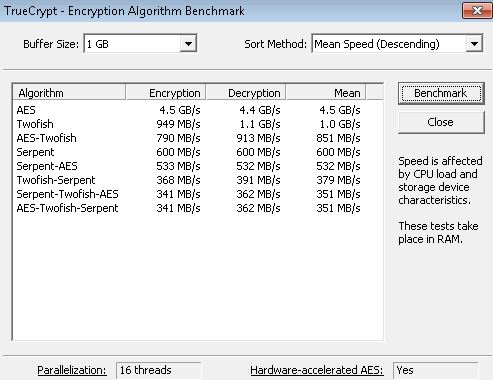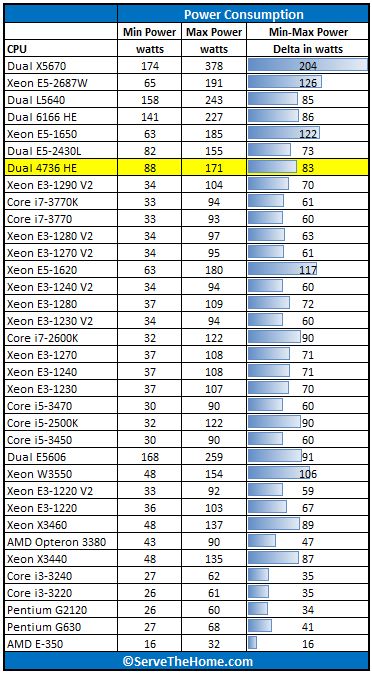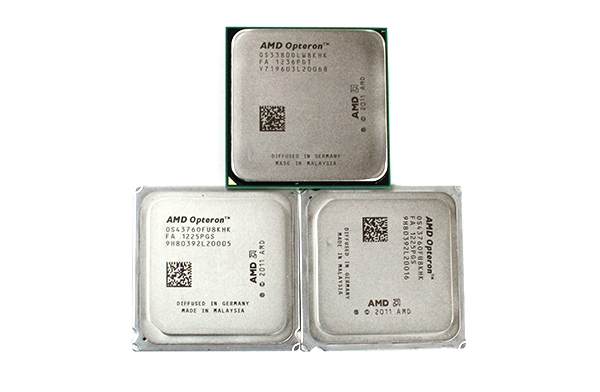The AMD Opteron 4376 HE is a mid-range server processor from AMD. It is also AMD’s fastest Opteron 4300 series “high efficiency part. Built on AMD’s Piledriver core architecture, each AMD Opteron 4376 HE has eight “cores”. The cores are serviced by 8MB (2MB per pair of cores) of L2 cache and 8MB L3 cache. These cores are built on a 32nm process yielding a TDP of only 65w. TurboCore 2.0 takes 2.6GHz base clock speeds and thermal conditions permitting, allows the chips to reach up to 3.6GHz. In dual configurations this yields up to 16 threads for the two CPUs and a formidable set of hardware.
Test Configuration
For this test, we assumed a basic dedicated or cloud server platform. This setup should be fairly typical of a dual socket cloud server.
- CPU: Dual AMD Opteron 4376 HE
- OS Drive: OCZ Vertex 4 256GB
- Enclosure: Norco RPC-4224
- Power Supply: Corsair AX750 750w 80Plus Gold PSU
- OS: Windows 8 Pro 64-bit, Ubuntu 12.04 Server LTS
- Motherboard: Supermicro H8DCL-6F
- Memory: 64GB Kingston ECC 1600 CL11 DDR3 8x 8GB RDIMMs
These should be fairly standard styles of Opteron 4300 series configurations.
Dual AMD Opteron 4376 HE Performance Tests
The performance suite is evolving but these applications give a fairly good cross-section of performance. Clearly, one would expect a different workload between the Intel Xeon E5-2687W CPU or a quad Opteron system and something found in a low-end, low-power server like a Pentium G630. It should be noted that the current Windows testing method is on the way out as the Linux test suite is being developed. Note for this, we are not publishing our normal Handbrake x264 encoding benchmarks as those have proven not to scale well with these systems.
Cinebench R11.5
We have been using Cinebench benchmarks for years but have held off using them on ServeTheHome.com because the primary focus of the site until the past few months has been predominantly storage servers. With the expansion of the site’s scope, Cinebench has been added to the test suite because it does represent a valuable benchmark of multi-threaded performance. We have had quite a few readers contact me about this type of performance for things like servers that are Adobe CS6 compute nodes and similar applications. Cinebench R11.5 is something that anyone can run on their Windows machines to get a relative idea of performance across CPUs as the application does scale very well across architectures and core/ thread counts.

In terms of raw multi-threaded CPU performance, the dual AMD Opteron 4376 HE system did well. It was faster than the Intel Xeon E3-1290 V2 which costs slightly less than two AMD Opteron 4376 HE chips. On the other hand it was a bit slower than the dual Intel Xeon E5-2430L chips. Keeping in mind that pricing for the Intel Xeon E5-2430L is about 30% higher right now than the AMD Opteron 4376 HE, this makes sense from a price/ performance standpoint.
7-Zip Compression Benchmark
7-Zip is an immensely popular compression application with an easy to use benchmark and has been a staple on this site for years. The 32MB benchmark size is used here to fit into low memory systems and virtual machines.

Again, one finds the dual AMD Opteron 4376 HE setup right about where one would expect it. The interesting result here may be the comparison to the dual AMD Opteron 6166 HE. Performance is closing in on the aging Magny Cours based dual Opteron 6166 HE system as the dual AMD Opteron 4376 HE setup falls just shy of it. Higher clock speeds, a microarchitecture that is two generations newer and higher memory clocks certainly help.
TrueCrypt Encryption Benchmarks
Truecrypt AES results show de-facto encryption acceleration. For example, users of Solaris 11 can utilize the AES acceleration features to see much higher throughput on encrypted volumes. Both AMD and Intel offer AES acceleration on their newer chips, so this is a fairly level benchmark and we use the 1GB size to produce more consistent results.

The dual AMD Opteron 4376 HE AES benchmarks show a clear benefit to the newer AES acceleration of Piledriver. At this point, on both the latest AMD Opterons and Intel Xeons (except the Atom Centertion) AES encryption is essentially “free”. Here is a quick look at one of the runs which gives an idea of what performance in other encryption schemes looks like.

The dual AMD Opteron 4376 HE system shows off the fact that it can hit around 1GB/s in Twofish and some strong numbers across. Piledriver is certainly helping.
Power Consumption
For these tests we measure using an Extech 380803 True RMS power analyzer. The Extech is a really nice unit that even records usage over time.

In terms of power consumption, the dual AMD Opteron 4376 HE setup is quite reasonable both in terms of min and max power consumption. It certainly is not the lowest power chip, but the 32nm process is clearly yielding solid results.
Conclusion
Overall, the dual AMD Opteron 4376 HE setup fared well in our benchmarks. More detail will come with the Linux benchmark suite’s release. This is certainly one of the reviews that is caught between the two releases. Still, the dual AMD Opteron 4376 HE system performed where we would expect given a retail price of around $500 per chip. Of course, large customers and OEMs will be able to get further discounts due to purchasing power. One other very important note here is that the dual AMD Opteron 4376 HE provides eight DIMM slots so it is somewhere between the typical low end uni-processor system (32GB max) and higher end systems with 12-24 DIMM slots in a dual socket configuration. Like the Opteron 6300 series, the Opteron 4300 series is limited to PCIe 2.0. With that said, the AMD Opteron 4376 HE has access to more PCIe lanes thorough typical northbridge/ southbridge configurations than many other server configurations out there.




